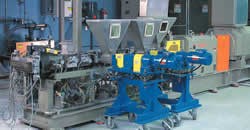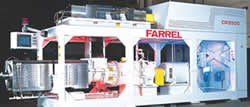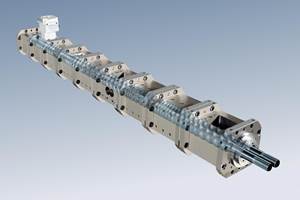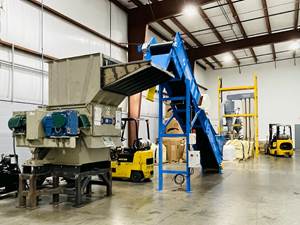NPE Highlights Compounding's Growth Niches
Show exhibitors say long-fiber wood composites, direct extrusion/compounding, and reactive compounding are where the action is.
General-purpose compounding markets continue to be plagued with overcapacity, but there are still niche areas of growth to be exploited. Not coincidentally, a large share of technology development is being aimed at those pockets of growth. Those themes stood out in interviews with compounding machinery exhibitors at the NPE show in Chicago last month. Machine makers are putting their R&D into combinations of wood fillers and long fibers of glass, cellulose, wheat, or flax. Corotating twin-screw use is also growing in direct extrusion/compounding of sheet, profile, and even film. Machine builders also report increased interest from toll compounders in reactive extrusion of TPEs, TPVs, and functionally grafted polyolefins with fillers and reinforcements.
Wood flour & long fibers
The buzz in compounding with wood fillers is combining wood and glass for direct extrusion of high-strength lumber profiles. Plastic lumber has long used wood fillers as extenders or glass fibers for extra strength, but did not combine the two until recently. One of the first systems for doing so was supplied last year to an unnamed processor by Leistritz.
At NPE, several makers of corotating twins discussed recent trials combining wood flour and long fibers. Coperion Corp. (formerly Werner & Pfleiderer) is exploring novel combinations such as pultruding long bamboo fibers in a wood composite and pultruding fiberglass in a highly filled compound.
In the U.S., Coperion’s approach to wood-filled compounding is to start with undried wood flour at the feed throat of a Megavolume corotating twin-screw extruder. Passage through the first four to six heated barrel segments extracts moisture. Then resin, colors, and additives are fed in through various side ports. The mixture then cascades into a single-screw melt pump.
Coperion is also using this technique for developmental compounds containing other natural fibers such as cellulose, kenaf, and wheat straw. Again, the process starts by drying the natural fibers in the twin-screw extruder and then adding plastic pellets downstream.
More recently, Coperion in Germany has taken a different tack. It reverses the order of events, starting by melting the plastic in the Megavolume twin-screw and then adding long wood fibers (1 to 5 mm) to the melt just before the die. In the U.S. process, wood goes in first because it is used as a filler, not a reinforcement, so breakage of the wood fibers isn’t a concern.
In the German approach, the wood is a long-fiber reinforcement intended to impart strength, so it’s added to the melt stream close to the die to avoid breaking the fibers. As a result, moisture must be vented downstream of wood-fiber entry. Loadings are 40% to 60% wood, depending on the properties desired.
ExtrusionTek Milacron says corotating twin-screws aren’t the only way to go for compounding wood flour. Milacron promotes its counter-rotating conical and parallel twins for direct extrusion/compounding of wood-filled profiles. Milacron’s TimberEx extrusion process for cellulose-filled composites uses its V-MEDS-L (Material Enhancement Delivery System with Vertical Feed) continuous unit to mix preblended composite formulations, heat them to drive off residual moisture, and then feed them to a conical or parallel twin-screw extruder.
Milacron has experimented in the past year and a half with preblended mixtures of chopped glass and wood flour. As a result of that work, Milacron added a second vent to its conical twins for improved moisture removal and higher throughput rates. (Milacron also offers the second vent as a retrofit for existing extruders.) Also new is a vent stuffer to clean out the wood particles that naturally accumulate in vents.
Entek Extruders is mixing developmental combinations of long glass and wood flour for direct extrusion of high-strength plastic boards, says president Larry Keith. Entek’s wood-composite process first melts the plastic, then side-feeds wood flour and adds glass just before the die. Entek is testing glass contents of 0.5% to 10% with wood contents of 30% to 70%. In the past 18 months, Entek redesigned its corotating twin-screw compounders to make them as much as 15% less expensive, depending on size.
Late last year, Farrel Corp. did a lot of development work using its corotating twin-rotor CP continuous mixer to feed 20% undried wood flour gravimetrically with resin pellets and additives at the feed throat. The melted and mixed compound then falls into a corotating twin-screw extruder, where chopped glass is added. Potential applications are direct extrusion of long, thin, high-strength profiles like broom handles.
Another recent novelty involving long fibers is using a Leistritz corotating twin-screw to make 1-in. long-glass pellets. Pellets with long fibers are typically made by pultrusion with a single-screw extruder. Such a process typically coats the outside of the fiber bundles but doesn’t wet out individual fibers the way twin-screw compounding does.
More direct extrusion
Davis-Standard sources say one of the fastest-growing areas of compounding is using corotating twins for direct extrusion of finished goods without a pelletizing step. One such line was recently delivered for making PS foam boards up to 48 in. wide—double the standard width—using CO2 and hydrocarbon blowing agents. Davis-Standard’s system extrudes the board with a 140-mm corotating twin-screw, the biggest the firm has ever built for extruded PS foam and possibly the biggest for that application anywhere.
Davis-Standard is also building a multi-layer cast film line using two corotating twin-screw and three single-screw extruders. Coperion supplies the corotating twins in an alliance with Davis-Standard for direct-extrusion/ compounding applications. This line will have a five-layer Cloeren feedblock and 48-in. die, plus an in-line MD orienter. The system will be used for pilot development of new structures like breathable films, high-barrier nanocomposite films, and synthetic paper with coatings and laminations. The line is being built for the Center for Applied Research on Polymers at the Ecole Polytechnique in Montreal. It will be installed late this year at the Lavergne Group, a Montreal-based compounder.
NFM/Welding Engineers launched its first system for wood-filled composites at NPE. It uses NFM’s TEM corotating twin-screw, which is built under license from Toshiba in Japan. TEM models are available from 26 to 240 mm diam. and up to 48:1 L/D with three vents. At NPE, NFM displayed its 58-mm wood-composite system for the first time. It feeds undried wood flour, plastic pellets, colorants, and additives together gravimetrically at the feed throat and can be used for pelletizing or for direct extrusion of profiles.
More complex reactions
Reactive compounding is generating some interest among toll compounders. “There is overcapacity in general compounding, so there is a trend for toll compounders to get into new specialties using reactive alloying,” says Wolfgang Hofer, president of Extruder Technologies, a custom machine builder and retrofitter. “They want to make a new compound without spending a lot of money, so they’re trying to run products that had been done before only by big resin companies.”
Chemical companies use very large corotating twin-screw extruders as small-scale reactors. These machines can be 150 to 300 mm diam., vs. 40 to 150 mm for one that would be used by a toll compounder. For example, Maris in Italy is testing one of its corotating twin screw extruders as a continuous reactor to break recycled PET down into liquid oligomers. The oligomer solution is then used to make polyurethane.
Compounders and resin companies are using corotating twin-screws to make polymer alloys. For example, they could graft maleic anhydride to PP. The resulting product can be used as a compatibilizer to alloy PP and nylon in a subsequent extrusion step.
Makers of corotating twin-screws also see use of reactive extrusion for nanocomposites to bind nano-particles into the polymer for better properties.
Reactive extruders are growing longer and more complex as some of the new compounds need longer residence times and more degassing. “Compounding machines are getting longer across the board, adding another vent or two,” says Charles Martin, general manager of Leistritz’ U.S. office. “They’re stringing together more operations, doing more additions of liquid, gas, and fillers and extraction of more volatiles.”
Davis-Standard sources agree that the number of process steps performed in continuous compounding has steadily increased. “We’ve built direct-extrusion/compounding systems with as many as 11 materials in a formulation,” says business-area manager Al Chrisbacher. “These systems tend to have double the output of a single-screw line—for example, 6000 to 7000 lb/hr with multiple extruders. The economies are much better.”
Coperion is building its longest corotating twin-screw reactive extruder ever—72:1 L/D—for delivery in two months to a resin company. The longest the firm had built before was 62:1. The 72:1 model is 120-mm diam. and needs the extra length for two long degassing zones.
Entek this year has also shipped its longest extruders ever. It built two 52:1 corotating twin-screws for reactive extrusion by resin companies.
NFM/Welding Engineers says it built a 72:1 counter-rotating devolatilizing extruder over 20 years ago and has built at least eight more since then that are either 60:1 or 72:1. The firm says its non-intermeshing twin-screws are particularly good at distributive mixing, whereas the corotating models are good at dispersive mixing.
Extruder Technologies retrofits machines for reactive processing by adding length, side-feed ports, and vacuum-venting systems. It also supplies such specialized reactive compounding equipment as three- or four-screw “vent stuffers.” These are feeders that devolatilize ingredients while feeding.
TPEs go reactive
Interest is reportedly growing in reactive extrusion of TPE and TPV compounds, driven by the relatively recent availability of EPDM rubbers in granular form, which are made by new gas-phase metallocene catalyst processes. Typically EPDM rubber comes in blocks or bales that have to be shredded. Styrenic, urethane, polyester, and nylon polymers are being alloyed with the granular metallocene EPDM. Berstorff says it expects high growth of 7% to 8%/yr for TPE and TPV reactive compounding markets through 2005.
The new TPE compounds fall into two broad categories—block copolymers where a rigid phase is dispersed in an elastic matrix, and those where an elastomeric phase is dispersed in a rigid matrix, says Martin Mack, Bertorff’s v.p. of R&D. In TPVs the elastic phase is crosslinked in the mixing section of the twin-screw extruder.
For TPE reactive compounding, Berstorff recently developed a new mixing element called the UP mixer. It is based on the barrier flight of a single-screw extruder, applied to form a barrier on a corotating twin-screw. This increases elongational mixing of the rigid and elastomeric phases and raises throughput. It also achieves further dispersion with less energy input than a typical kneading block, says Berstorff, which showed the UP elements at NPE in Chicago last month.
Related Content
Processing Megatrends Drive New Product Developments at NPE2024
It’s all about sustainability and the circular economy, and it will be on display in Orlando across all the major processes. But there will be plenty to see in automation, AI and machine learning as well.
Read MoreHow to Configure Your Twin-Screw Barrel Layout
In twin-screw compounding, most engineers recognize the benefits of being able to configure screw elements. Here’s what you need to know about sequencing barrel sections.
Read MoreWhat to Know About Your Materials When Choosing a Feeder
Feeder performance is crucial to operating extrusion and compounding lines. And consistent, reliable feeding depends in large part on selecting a feeder compatible with the materials and additives you intend to process. Follow these tips to analyze your feeder requirements.
Read MoreEngineering Resins Compounder Expands to Take on More Scrap
Polymer Resources responds to sustainability push by upgrading plant with grinding and shredding equipment to take on both postindustrial and postconsumer reclaim.
Read MoreRead Next
Lead the Conversation, Change the Conversation
Coverage of single-use plastics can be both misleading and demoralizing. Here are 10 tips for changing the perception of the plastics industry at your company and in your community.
Read MoreFor PLASTICS' CEO Seaholm, NPE to Shine Light on Sustainability Successes
With advocacy, communication and sustainability as three main pillars, Seaholm leads a trade association to NPE that ‘is more active today than we have ever been.’
Read MoreMaking the Circular Economy a Reality
Driven by brand owner demands and new worldwide legislation, the entire supply chain is working toward the shift to circularity, with some evidence the circular economy has already begun.
Read More


























